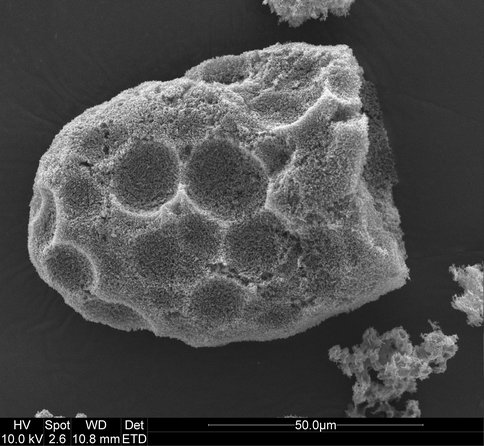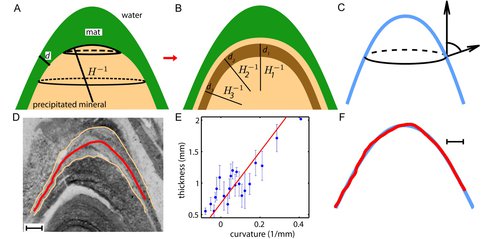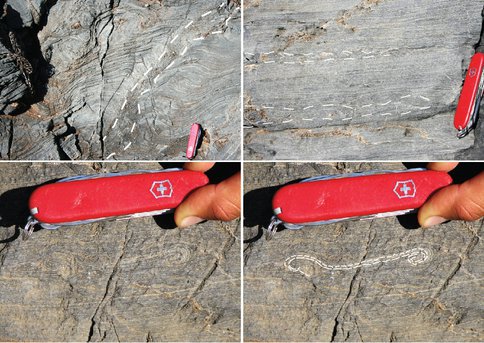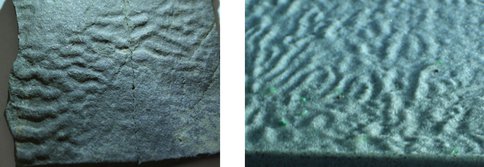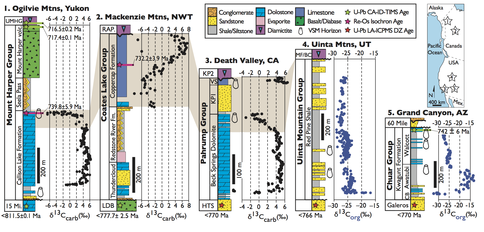2013 Annual Science Report
 Massachusetts Institute of Technology
Reporting | SEP 2012 – AUG 2013
Massachusetts Institute of Technology
Reporting | SEP 2012 – AUG 2013
Life and Environments: Proterozoic Geology, Geochemistry and Paleontology
Project Summary
The search for life on other planets, including Mars, is inevitably a comparative exercise with Earth as the only known planet that carries confirmed biosignatures (chemical or morphological). Often, these pursuits bridge multiple disciplines from sedimentology/stratigraphy, classic paleontology, inorganic and isotope geochemistry to the study and distribution of specific organic compounds that are considered good proxies for particular sorts of organisms (i.e. biomarkers). The Ediacaran Period (635 – 542 Ma) sees the first direct evidence for the rise of multicellularity, which is arguably one of the most critical biological transitions in the rock record. Equally intriguing is the immediately pre-ceding interval, the Cryogenian Period (850 – 635 Ma) with global glaciations, massive perturbations in geochemical cycles, a probable rise of atmospheric oxygen, and an apparent evolutionary radiation within the eukaryotic domain. In contrast to the canonical view, emerging research on Neoproterozoic sedimentary successions by the MIT-NAI team now suggests that much of the apparently sudden rise of animal life that is manifested in the Ediacaran sedimentary record was initiated by events that happened earlier, during the late Mesoproterozoic Era and through the Cryogenian Period (1200 – 650 Ma). Our work seeks to illuminate this time period by documenting the stratigraphy, isotopic records, fossil assemblages, and biomarker contents of critical Meso- to Neoproterozoic transitions in well-preserved Proterozoic sections from Canada and Russia. We especially seek to understand the genetic links and time relationships (which inform rates) among tectonic, geochemical and biological changes.
Project Progress
PI Cohen has been continuing her work searching the microfossil record of early eukaryotic life in Proterozoic strata. This year, Cohen has macerated or thin sectioned over 120 samples from the Proterozoic of northwestern Canada, samples collected by Cohen, Macdonald, Strauss, Rooney, and collaborators. The most intriguing fossil material thus far was collected by Strauss from the Callison Lake Dolostone (CLD) and contains extremely well preserved vase-shaped microfossils (VSM, Figure 1), believed to be the remains of testate (shell-forming) amoeba. These VSMs are very diverse and, interestingly, preserved not only in thin section but also in macerated shale material, which is a new taphonomic window for this important Neoproterozoic fossil group. The CLD VSMs share similarities with VSMs from the Chuar Group of Arizona, and further work on these fossils will illuminate pre-Sturtian glaciation ecocystems and diversity. It will also provide critical information on taphonomic and preservational pathways for testate amoebae. Cohen is also working on a new database of eukaryotic fossil occurrences in collaboration with Macdonald, to illuminate long-term trends in diversity and work towards better integrating the fossil record with geochemical changes in the Earth system. Cohen is also wrapping up a project with Bosak and Macdonald on enigmatic putative macroalgae from the interglacial Cryogenian of Mongolia and comparing the similarities and differences between these structures and fossilized microbial mats.
PI Bosak is investigating the environmental and taphonomic conditions during the Mesoproterozoic, the Neoproterozoic and the Early Cambrian, as recorded in the morphologies of sedimentary structures such as stromatolites and wrinkle structures and in the record of Cryogenian eukaryotes. A former graduate student, Alex Petroff, supervised by Rothman and Bosak and in collaboration with N. Beukes (U. Johannesburg), published an article describing a model (Figure 2) that can be used to understand the growth of conical stromatolites of all sizes by analyzing the geometry of their laminae (Petroff et al., 2013).
Bosak, Petroff and A. Knoll published an article reviewing the developments in stromatolite morphogenesis in the last decade (Bosak et al., 2013a) and an article reviewing experimental microbial sedimentology and its applications to the interpretations of sedimentary structures in the Neoproterozoic cap carbonates (Bosak et al., 2013b).
The last article outlined some hypotheses that coupled the morphology and cementation of sedimentary structures to the interactions among the flow (waves and currents), sedimentary bedforms and microbial growth. Giulio Mariotti, a postdoctoral fellow advised by Bosak and T. Perron at MIT, established an experimental system to test these hypotheses and showed how the interactions between the wave field, sediment motion and microbial growth can shape elongated stromatolites in sandy sediments, such as those in Shark Bay, Australia (Mariotti et al., in review). Mariotti’s experiments (in collaboration with S. Pruss, Smith College) also produced the first comprehensive model for the formation of wrinkle structures (Figure 4), enigmatic mm-scale ridges and pits that occur in many Ediacaran and Cambrian siliciclastic deposits that also preserve impressions of macroscopic organisms and animals. Mariotti et al., GSA and AGU abstract). This model reveals the ability of microbial aggregates (fragments of microbial mats) to shape bare sand in the presence of weak oscillatory flow and create patterns in siliciclastic sediments and initiate patterns in stromatolites. This mechanism contrasts with the previously suggested hypotheses of strong oscillatory flow over surfaces initially stabilized by microbes. Experiments done by S. Newman, a graduate student, and J. Henebry, a high school student (both supervised by Bosak) are currently testing the influence of seawater chemistry on the preservation of microbial mat features in siliciclastic settings and the formation of calcified microbial aggregates in carbonate depositing environments in the Neoproterozoic and Cambrian.
Bosak and E. Matys, a graduate student at MIT, also co-authored an article (in collaboration with S. Pruss, F. Macdonald and D. Lahr) describing how the morphology and the preservation of assemblages of agglutinated fossils from the Rasthof Formation, Namibia (Figure 5) vary in space and as a function of facies (Dalton et al., 2013). These variations imply former ecological variations among eukaryotes that lived in the aftermath of the first Neoproterozoic low-latitude glaciation and will guide future identifications of the most fossiliferous facies in Cryogenian carbonates. Min Sub Sim, a former graduate student supervised by Bosak and S. Ono (MIT) and collaborators (J. Wall, U. Missouri), used mutants of a sulfate reducing bacterium to demonstrate the dependence of S isotope fractionation during microbial sulfate reduction on pathways that transfer electrons from C compounds (sources of reducing power) to sulfate (Sim et al., 2013). This work complicates standard models of microbial sulfate reduction and has implications for interpretations of environmental conditions based on S isotope fractionations in sedimentary sulfates and sulfides.

PI Macdonald has been continuing field studies coupled with geochronology and geochemistry in NW Canada, Mongolia, Namibia, and Death Valley. In NW Canada we have been providing context for newly discovered VSMs in the Callison Lake Dolostone and importantly directly dated the shale horizon in which they occur with Re/Os to 739+/-6 Ma, which is indistinguishable with the U/Pb age of 742+/-6 Ma on an ash associated with the VSMs in the Chuar Group in the Grand Canyon. A manuscript on Re/Os ages bracketing the glacial deposits in NW Canada is about to come out in PNAS (Rooney et al., in press), and we are currently preparing a manuscript on the discovery of these fossils and the age. This work is in collaboration with team members Cohen, Strauss, and Rooney. In NW Canada, we also recently published a synthesis of Ediacaran stratigraphy (Macdonald et al., 2013a). In this publication we reported the discovery of the Shuram anomaly and reassigned the age of the FAD of Ediacaran fauna from the early Ediacaran Sheepbed Formation to the late Ediacaran June beds.
In Mongolia, with team members Macdonald, Smith and Bold are wrapping up a couple of manuscripts on the environmental setting for the rich Cryogenian mircofossils described by Bosak and Cohen. Team member Ross Anderson joined us in the field to start work on the taphonomy of these fossils. In Namibia, team members Macdonald, Strauss and Pruss reported the discovery of large, complex trace fossils present in strata >5 Myrs older than the Precambrian-Cambrian boundary (Macdonald et al., in press). In Death Valley, team members Macdonald, Smith and Pruss reassessed the geological context of microfossils, including VSMs, which were previously suggested to be a syn-Snowball Earth assemblage. We determined that this occurrence is actually in a slump block from the underlying strata that was deposited coeval with the Callison Lake Dolostone and Chuar Formation, and thus cannot be used to assess the severity of Snowball Earth. These results were recently published in GSA Bulletin (Macdonald et al., 2013b).
Publications
-
Bosak, T., Knoll, A. H., & Petroff, A. P. (2013). The Meaning of Stromatolites. Annual Review of Earth and Planetary Sciences, 41(1), 21–44. doi:10.1146/annurev-earth-042711-105327
-
Dalton, L. A., Bosak, T., MacDonald, F. A., Lahr, D. J. G., & Pruss, S. B. (2013). PRESERVATIONAL AND MORPHOLOGICAL VARIABILITY OF ASSEMBLAGES OF AGGLUTINATED EUKARYOTES IN CRYOGENIAN CAP CARBONATES OF NORTHERN NAMIBIA. PALAIOS, 28(2), 67–79. doi:10.2110/palo.2012.p12-084r
-
MacDonald, F. A., Prave, A. R., Petterson, R., Smith, E. F., Pruss, S. B., Oates, K., … Fallick, A. E. (2013). The Laurentian record of Neoproterozoic glaciation, tectonism, and eukaryotic evolution in Death Valley, California. Geological Society of America Bulletin, 125(7-8), 1203–1223. doi:10.1130/b30789.1
-
MacDonald, F. A., Pruss, S. B., & Strauss, J. V. (2014). Trace Fossils with Spreiten from the Late Ediacaran Nama Group, Namibia: Complex Feeding Patterns Five Million Years Before The Precambrian–Cambrian Boundary. Journal of Paleontology, 88(2), 299–308. doi:10.1666/13-042
-
MacDonald, F. A., Strauss, J. V., Sperling, E. A., Halverson, G. P., Narbonne, G. M., Johnston, D. T., … Higgins, J. A. (2013). The stratigraphic relationship between the Shuram carbon isotope excursion, the oxygenation of Neoproterozoic oceans, and the first appearance of the Ediacara biota and bilaterian trace fossils in northwestern Canada. Chemical Geology, 362, 250–272. doi:10.1016/j.chemgeo.2013.05.032
-
Petroff, A. P., Beukes, N. J., Rothman, D. H., & Bosak, T. (2013). Biofilm Growth and Fossil Form. Physical Review X, 3(4), None. doi:10.1103/physrevx.3.041012
-
Sim, M. S., Wang, D. T., Zane, G. M., Wall, J. D., Bosak, T., & Ono, S. (2013). Fractionation of sulfur isotopes by Desulfovibrio vulgaris mutants lacking hydrogenases or type I tetraheme cytochrome c3. Frontiers in Microbiology, 4. doi:10.3389/fmicb.2013.00171
- Bosak, T., Mariotti, G., Perron, J.T., MacDonald, F.A. & Pruss, S.B. (In Review). Microbial sedimentology of stromatolites in the Neoproterozoic cap carbonates, Ecosystems Paleobiology and Geobiology. Paleontological Society, 19.
- Cohen, P., Matys, E.D., MacDonald, F.A., Pruss, S.B. & Bosak, T. (In Review). Putative macroalgal fossils from the Cryogenian of Mongolia.
- Mariotti, G., Perron, J.T. & Bosak, T. (In Review). Elongation of stromatolites through feedbacks between flow, sediment motion and microbial growth on sand bars.
-
PROJECT INVESTIGATORS:
-
PROJECT MEMBERS:
Tanja Bosak
Co-Investigator
Derek Briggs
Co-Investigator
Phoebe Cohen
Co-Investigator
David Johnston
Co-Investigator
Andrew Knoll
Co-Investigator
Francis Macdonald
Co-Investigator
Ann Pearson
Co-Investigator
Dan Rothman
Co-Investigator
Ross Anderson
Collaborator
Nicolas Beukes
Collaborator
Uyanga Bold
Collaborator
Ben Cowie
Collaborator
Jessica Creveling
Collaborator
Simon Darroch
Collaborator
Mario Giordano
Collaborator
Peter Girguis
Collaborator
Lindsay Hays
Collaborator
Linda Kah
Collaborator
Benjamin Kotrc
Collaborator
Stephanie Kusch
Collaborator
Daniel Lahr
Collaborator
Lisa Levin
Collaborator
Giulio Mariotti
Collaborator
Emily Matys
Collaborator
Victoria McCoy
Collaborator
Sharon Newman
Collaborator
Madeline O'Grady
Collaborator
Shuhei Ono
Collaborator
Taylor Perron
Collaborator
Alexander Petroff
Collaborator
Simon Poulton
Collaborator
Sara Pruss
Collaborator
Simona Ratti
Collaborator
Alan Rooney
Collaborator
Daniel Schrag
Collaborator
Min-Sub Sim
Collaborator
Emily Smith
Collaborator
Erik Sperling
Collaborator
Justin Strauss
Collaborator
Lidya Tarhan
Collaborator
Judy Wall
Collaborator
David Wang
Collaborator
Elise Wilkes
Collaborator
-
RELATED OBJECTIVES:
Objective 4.1
Earth's early biosphere.
Objective 4.2
Production of complex life.
